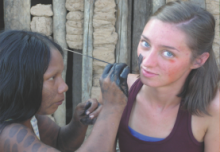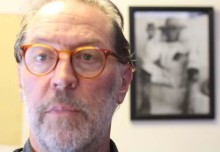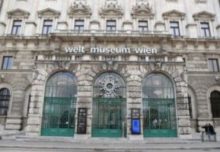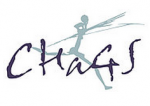 Interview with William Balée: Anthropology and the future of the Amazon
Interview with William Balée: Anthropology and the future of the Amazon
Looking forward to the Tenth SALSA Conference in New Orleans next January, Lauren Dodaro, a graduate student at Tulane University, interviewed conference organizer William Balée about his career in anthropology, his work in the Amazon, and his involvement with SALSA.
What led you to choose anthropology as a career?
I chose anthropology initially as a major for pragmatic reasons. I wanted to get into Phi Beta Kappa and I’d read that the way to do that would be to take a wide range of courses and as a sophomore at the University of Florida I had to decide what major to choose. Even though I hadn’t taken an anthropology course yet, I could see from the schedule of requirements that the anthropology department had interesting courses. It also had the fewest requirements for you to have to major in, in terms of credit requirements. So, I took that option. As an undergraduate, I really did the liberal arts and sciences thing. I took as many different kinds of courses as I could and majored in anthropology and fell in love with the field. I made Phi Beta Kappa, too. I did an honors thesis under the supervision of an Amazonianist, Charles Wagley, who, although he didn’t have me do a thesis on the Amazon, got me interested in many ways in thinking about the possibility of working in South America.
And then I decided to apply for graduate school and I went to Columbia University; at the time it represented radically different but popular approaches to anthropology at the time in the sense of you had both cultural materialism and structural Marxism being strong currents; cultural materialists were mainly represented by Marvin Harris and structural Marxists by Alexander Alland and others. In between was Robert Murphy, who was an Amazonianist specializing in kind of a structuralism but also a sort of dialectical skepticism of his own, for which he was well known at the time, and is still known. And he became my advisor because I had decided I did want to work in Lowland South America by that point. That was my second year of graduate school.
I consulted again with Charles Wagley because I would go back from New York to Florida, where my parents and family lived, so I would often visit Charles Wagley in those times in Gainesville. I was interested in a Tupí-Guaraní group, but I didn’t know which one. The reason was I was part of a warfare seminar run by students at Columbia in the anthropology department—Brian Ferguson was in charge—and I got very interested in the question of warfare of the Tupinambá people of Brazil at the time of the European conquest. And so I thought it might be interesting to try to pursue this as a dissertation topic—not the historical or the ethnohistory part, but rather to look at Tupí-Guaranían society today in relation to a contact situation. I asked Charles Wagley about that and he said, “Why don’t you study the Urubu?,” as they were called—the Ka’apor, their self-designation. There was a road that was recently built through their lands connecting São Luís to Belém, and it was a federal highway. So I did, and that’s how I started with the Ka’apor and committed thereafter to an anthropological career.
How did you first become interested in working in the Amazon?
What first interested me was the possibility of seeing the connection between an indigenous group and their environment because that was a very popular theme at the time I was a graduate student. It was called cultural ecology, although I did not end up pursuing cultural ecology; I came up with another approach, historical ecology, to the way people relate to the environment.
That certainly is the entrée that I had into the field; it was to study the relationship between indigenous people in a rainforest environment and the surrounding flora and fauna and landscape that they were in. The main idea there was to see what impacts were the arrival of the settlers, via the highway, having on this relationship between the Ka’apor and the environment around them. That was the main reason that I picked the Ka’apor, because they were having this issue of the highway into their lands. Ever since that time it’s been increasingly non-stop incursions into their lands, and it was partly because of the highway but also because of the frontier encroaching in on them from all sides.
I was interested in how they are connected to their environment, and vice versa, how they influence those environments and the influences that they had on the environment have an impact on the way they use the resources later.
So, I looked at a number of other Tupí-Guaraní groups because I wanted to understand how similar or how different the Ka’apor were—their uses of landscape and how much of this knowledge that they obviously had, which was profound, could be traced back to earlier indigenous roots. I got involved in that work on a postdoc at the New York Botanical Garden.
How did your involvement with SALSA start?
My involvement with SALSA began with a lunch conversation with Jeffrey Ehrenreich some years ago, the year before we had the precursor meeting of SALSA—that’s what we call it—which was held in January of 2001. It was actually January 11th to January 14th 2001. And Jeffrey and I thought it would be a good idea to try to get the Amazonianists grouped together the way he and I had known it in New York and in Vermont because there had been a long standing, wonderful series of conferences that Kenneth Kensinger had sponsored there at Bennington over many years. There had also been, in New York, monthly meetings of what we would call the Caucus on South American Indians. New York city at the time, in the 1970s and ‘80s, was a great place for lowland South Americanist research because we had so many specialists to draw on in the tri-state area. That was pretty much under the inspiration of Robert Murphy, in fact he had that group going and we had people from City University, from different colleges in the New York City area, plus Columbia, coming to Manhattan for monthly meetings of the caucus and presenting papers and getting to know one another. People would come from as far away as Yale and even Bennington, Ken Kensinger would come from there to give papers. So we had a great group going at that time.
With the passing of Robert Murphy and the changes that took place in that group sort of going their separate ways, Jeffrey and I thought it would be a good idea to try to get as many Amazonianists together, including the younger people who didn’t have anything to do with the Bennington meeting, to come to a new meeting and perhaps even to consider the possibility of starting a new society as a 501C3, to see if they were interested in that, and also to explore the possibility of getting a journal because successful societies have journals. They also have conferences, so we wanted to see if people were interested in this. At that meeting we did decide—people voted—that we would proceed to form a new society for the anthropology of lowland South America with the acronym SALSA. That was Don Pollock’s idea and it was pretty catchy; we liked it. And it took a while to come up with the right title for the journal, but Tipití was finally the one, and I think Jeffrey Ehrenreich came up with that. We had a meeting of a steering community here in October of 2001, sponsored by the Stone Center for Latin American Studies, to found this new society officially as a 501C3, which means a nonprofit learned society with a corporate status, and that we were able to successfully do. The mission statement comes from that very first meeting, by the way, this is on the webpage for SALSA. I remember distinctly that those were the words that we as the precursor group to SALSA chose to be the mission statement for the society.
In your view, what are the most important benefits of collaboration in lowland South American studies?
Dr. Balée: First of all, enlightenment. Particularly when the collaboration is cross-disciplinary. In my career, I have had the privilege to have had very instructive collaboration with scientists in numerous fields: geographers, archaeologists, botanists, ecologists, linguists, others—I would say scholars in many fields, not necessarily scientists. They have enriched my own understanding because I believe that virtually no problem that one can identify as a research issue in the Amazon can be solved with a single discipline in that area, perhaps partly because it is so diverse in the best sense of the term—diverse in species, diverse in people, diverse in language, and diverse in culture—that it really is not feasible to try to solve a research problem within a single established discipline of Western academia. So I think collaboration is a wonderful tool to open our own understandings of this vast panorama of human diversity and natural diversity.
What areas of study within lowland South American anthropology are you most excited to see grow and why?
Well, first of all, there’s no doubt that archaeology has been the most important in the sense of the growing aspect because it came from very little in the last 25, 30 years, starting with just a small handful of archaeologists, and now there are hundreds. To be sure, a lot of them are students still, but there’s also a lot of PhDs and a lot of them are very cross-disciplinary as well. They’re interested in paleoecology and they work with paleoecologists. They use some very sophisticated tools that are now available in the world of radiocarbon dating and excavation methodologies with new ways of determining what’s in the ground. And also now you have the emergence of this LIDAR technology. So, archaeology with technology that they have been using together constitute, I think, one of the biggest advances in anthropological knowledge in the last 25, 30 years, that I can see in the 4 fields.
Also, linguistics has been expanding considerably with the coverage of more languages than ever before known in terms of the basic descriptions that were not available before. There are many more trained linguists in South American ethnology and linguistic anthropologists working with indigenous languages than there were before as well.
What hasn’t grown much is biological anthropology, but I do see a lot of potential for it, particularly in the area of studies of human nutrition and even food security, together with the usual topics of primatology, which have always been sort of the backdrop of the main work in biological anthropology. I see a really strong possibility of nutrition and food security issues related to biological anthropology that connects to other fields as well.
And, finally, in cultural anthropology, one of the most interesting things has been the increasing dialogue that ethnographers have had with these other fields. Together with significant new strides trying to document ethnographic societies that are threatened with expansion of global capital, losing very rapidly their traditional frontiers as they are closed in upon by expanding national societies. That continues to be one of the most important things that ethnography can do for the other fields of anthropology and for human knowledge in general is to have that personal, participant observation experience recorded for the present and for posterity as witness to the wonderful diversity of indigenous cultures and societies in South America.
How does anthropological study contribute to contemporary lowland South America?
Anthropological study is contributing a lot to contemporary lowland South America in the sense of making the studies of past societies become incredibly relevant to the current situation. As with, for example, the study of the dark earth, done by, to be sure, soil scientists, geographers, and chemists—but, no less has this area been made relevant by archaeologists and cultural anthropologists who have studied the impact of the dark earth with regard to contemporary societies who use the dark earth because it is so productive for their crops, and also for the archaeological ones where you find tremendous amounts of cultural material within the refuse and in the remains associated with the black earth, or the dark earth. So that’s one area where there’s a huge potential to contribution to food security, not just in the Amazon region, but elsewhere in our modern world where we have to remember that out of 7 billion people, 1 billion go hungry every single day. And it’s mostly in the tropical world. This is a possible way to try to alleviate some of that if applied properly and if it can be reproduced, which is still a question. But it’s certainly a very important issue, even if it is somewhat understated—I think a lot of people don’t understand the potential for it. But it’s going to become more important as time goes by.
I think that, as far as cultural anthropology is concerned, we have a great deal still to learn from ethnography because cultures of South America are changing faster than ever. That’s why we’re never going to be without work because it’s not as if all of these cultures have been described—they haven’t been. Even the ones that have been described are changing really rapidly, thanks in part to globalization and things like the introduction of what they call in Portuguese, pontes de cultura, that means “cultural bridges.” What they really are are access points for the Internet. To be sure, there are not many of these in the Amazon rainforest, but they often are not far, in modern terms, from local villages, particularly because you have that postmodern time and space compression where it used to be people would be walking for 30 km to get out of their village. Now they might be riding motorcycles, and whereas walking 30 km might take a couple of days non-stop, on a motorcycle you can do it in a day or less and be in some place where you have access to social media and digital technologies unlike anything ever before in the context of South American indigenous culture. I think that the relevance of cultural anthropology is, in the context, undeniable, and inimitable, it has to be done too.
Thank you Dr. Balée for sharing your thoughts on your career, SALSA, and anthropology in lowland South America.
September 17, 2015










